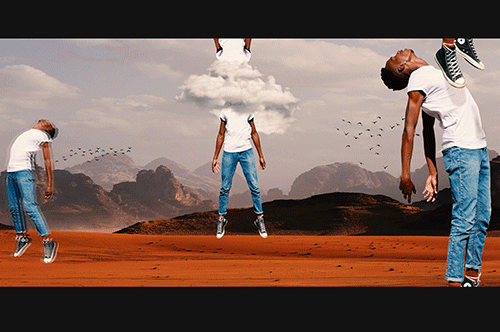You may look yet not see, or you may not see because you didn’t look. Jean-Claude Tjitamunisa, however, sees because he makes it a point to look, making people wonder what goes through his mind when they see him pointing his camera up to what looks like nothing.
“I notice where roofs, windows and corners of buildings meet the skies. The contrast in the colours, the reflections on the windows, and the textures. Each building has a different personality and story. What intrigues me the most, however, are the cracks on the walls, the rust and the peeling paint. To me, they resemble human imperfections,” he says on his Instagram page.
The visual artist, who has been doing architectural photography for four years, believes that “as much as we live in the same world, we all have our own perceptions in life, and we should be sharing them with each other through different forms of artistic mediums”.
His photographs are currently on show at the Namibian Arts Association Gallery in his first solo exhibition under the theme ‘UNSEEN’. It launched on 15 August, and ends tonight.
Queried on the sidelines of the exhibition about what draws him to abstract architectural photography, he said it complements his personality.
“I believe myself to be a multi-faceted being who gets to discover new things about myself, just as people discovered that those were buildings they ‘saw’ every day, but didn’t notice until I showed them.”
Tjitamunisa does not define the art of photography as simple or complex. “It all depends on how you interpret the art, which could be very close to what the artist was thinking, or completely off”.
Comparing abstract architectural photography to other types of photography is a form of expression, and just like other types of photography, it is not for everyone.
“Some will love it, and others not. What sets abstract architectural photography apart from the rest is that it is a fun and personal way of seeing architecture.”
Tjitamunisa said the exhibition started off as a second-year photography assignment by his lecturer Kristin Capp at the College of the Arts to shoot any subject of their choice. “I walked for months around the city, looking like a mad person with my head always up, and sometimes standing in the middle of the streets to get some of these shots.” Since then, UNSEEN has been published in Issue 3 of the ‘Doek! Literary Magazine’.
Asked about his perceptions of the exhibition, he said many people couldn’t guess most of the buildings, and he thus hopes his photos would spur them on to look around their surroundings even more, and hopefully discover beauty in what they didn’t notice before. “I would love for everyone to interpret the images as they see them. Someone brought up how the angles were the most intriguing thing to them, and another loved the colours in one of the images as it reminded her of the calm before a storm,” he said, adding that he loved how the pictures resonate differently with people.
As expected, guests doted on his work and kept bringing up how they would have never thought of capturing such images.
“I believe the images are easy to orientate yourself around. It is just trying to figure out which building is which. That was interesting to hear people guess.” Apart from architectural photography, Tjitamunisa also does boudoir, conceptual and fashion photography. What’s more is that he is a model and digital visual artist.
According to him, some people love boudoir art and others do not.
“I believe nakedness, which is something we shy away from so badly due to influences such as religion, is a form of healing as it takes a lot of self-accepting and courage to be fully confident in one’s self-image and body.” His description of conceptual photography is “being a painter, but with the lens being the brush. It allows me to decide what message I want to show and tell using photography”.
Tjitamunisa trusts viewers to comprehend his conceptual photography, as he intentionally stages his muses and the scenes to make it clear.
When it comes to fashion photography, he said since he is a model and photographer, it allows him to combine two of his favourite things.
“Also, due to my experience as a model, I get to see things that another photographer might miss.” He photographed local brands such as ‡Nu/Gôa Accessories, MNCreations and Sarakule – a Malian-French fashion brand. In future, Tjitamunisa plans to work with more local brands and creatives, and take Namibia to the world through his work.
– emariahaipinge@gmail.com


